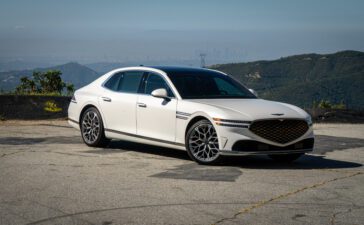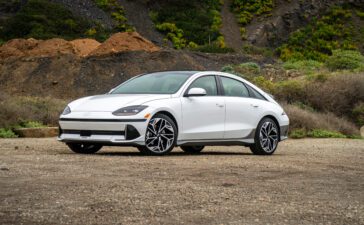“Now presenting our brand-new (insert new EV here), with a 50-kWh battery pack and 300 kW motors,” exclaims some extravagant press release from yet another startup. While it’s quite nice of you to spill all the beans like that, I’m still left wondering what the heck some of these measurements mean, and I’m sure some of you are too.
Welcome to this blooming age in the automotive landscape, where electrified cars stand on as big a pedestal as traditional dinosaur-powered performance vehicles. So many newfangled machines. So much innovative tech. Yet, interestingly, there’s not much in the way of explanation behind some of the most basic terminology, and what few definitions do exist lie buried under mounds of glitzy press material and spec sheet drag racing.
We’ve all read the brochures and the magazine reviews, diving into the colorful world of fully electric cars and plug-in hybrids. They’ll toss around new terminology like it’s already in the common vernacular, ignoring the fact that this is still relatively fresh tech being drip-fed to the world. Therefore, many terms haven’t fully clicked in people’s minds. But hopefully, this new explainer series should clear the fog around these words that are becoming as household as “horsepower” or “miles per gallon.”
Our inaugural lessons to kick off this series: what the heck even are “kilowatts,” how do they relate to electric cars, and how do they pair with the equally-tossed “kilowatt-hours?” Well, I’m glad I asked – and hopefully drove enough interest to entrap you here – because it’s time to get schooled in five minutes or less.
What is a killowatt?
This frequently-spoken term is not exclusive to EVs or electricity and can trace its core components back to pretty much any of our high school science and math classes. Anyone who has ever stumbled across a German auto magazine will likely guess where this is going.
Kilowatts are merely a metric measurement of power output, just like horsepower. Plain and simple.
A kilowatt (kW), which translates to 1,000 watts (W), is the alternate unit of measurement if you’re too cool for horsepower. If you want to click with your new friends from Frankfurt, talk about how many kilowatts the straight-six in their 1995 C36 AMG makes. There’s even a brainless, one-step formula for converting kilowatts into ponies. Simply multiply your kilowatts by 1.341.
For instance, let’s say you stumble across aforeign auto magazine talking about how the E92 M3 GTS had a power output of 331 kW – again, metric, so 331,000 W if you wanted to break it down. Before you scroll another line down the spec sheet looking for a pre-calculated conversion, you can multiply that 331 by 1.341 to get 443.87, on par with the manufacturer-claimed 444 horsepower.
Bingo! Easy, right?
Shift over to electric cars. Just as horsepower has become the ubiquitous unit of power measurement for internal combustion engines, the kilowatt has achieved a similar status for electric motors and may be used to denote output before official horsepower and torque ratings are published. The methodology for translating power measurements remains unchanged from pistons and cylinders to stators and magnets. Imagine some gilded brochure for the Tesla Model S Plaid that states that its motors’ combined output equals 760 kW. Multiply that by 1.341, and bam! 1,019.16, in line with its 1,020 horsepower rating.
Tracking? Heck yeah, you are!
But the way that kilowatts relate to EVs is only half the story. One must also understand their relation to battery packs.
What is a kilowatt-hour?
While electric motors measure power output by kilowatts, battery packs measure energy capacity by kilowatt-hours. If you’ve read this far and decided you can’t stand me, please consult this handy YouTube video below for its breakdown of what a watt hour is and how it’s calculated. However, should you despise video explainers more than my written words, then please bear with me, as there’s a bit more to it than what we’ve discussed so far.
“How battery capacity is measured and what is Wh? (Watt Hour)”
A kilowatt-hour (kWh) determines how much energy can be expended over a unit of time, which, in the context of EVs, directly relates to a vehicle’s maximum power output and range. While the kWh is now a standard unit for measuring EV battery capacity, it’s long been a common unit of measurement for energy consumption in homes and appliances.
Back to the Model S Plaid, let’s say you’re flooring it down the highway at a perfectly legal speed. Your foot’s all the way down on the throttle, extracting every bit of that 760 kW output. Welp. Congrats. You’ve killed it. The car dies within seven to eight minutes or roughly 0.13 hours after starting with a full charge, as the Model S Plaid’s battery has a capacity of 100 kWh, meaning it can expel 100 kW of power over roughly an hour.
Now, let’s switch things up and say you’re on your way home from doing Tesla owner things, such as hot yoga and overpaying for bread with avocado on it (this is satire, by the way, so relax.) You’re taking it easy and hypermiling every stretch of the way, probably only expending an average of 50 kW during your drive. You’ll likely see about two hours’ worth of use and be able to travel a significantly farther distance with that 100 kWh battery than if you were to demand maximum attack from the electric motors a majority of the time.
Humorously, if you build some Frankenstein bastard child of a project car using the Plaid motors hooked up to a base model Nissan Leaf’s 40 kWh battery and went flat out, the party would be over in less than three minutes. Do with that information as you will, project car YouTubers of the world.
That’s perhaps the simplest way to explain its relevance to prospective consumers. Smaller battery packs with lower capacities will result in shorter overall ranges and limit how much power an EV can reasonably output, while larger battery packs flip the script, enabling longer distances and more kW of power.
It’s why you often see the pricier, long-range variants of electric vehicles sport more powerful motor setups and longer overall ranges, thanks to their higher kWh rating. And it’s partly why some performance variants with even more powerful motors wired to the same batteries (or even slightly bigger) may have shorter ranges, as their elevated performance now demands more from the battery, in addition to other factors like stickier tires, thermal challenges, and aero changes.
“Watt do you mean it can’t charge any faster?”
Last tidbit! Before we go too deep down a rabbit hole that’d require another article, let’s discuss how kilowatts and kilowatt hours pertain to charging your EV. Yes, everyone’s least favorite part.
Just as kilowatts measure the power coming out of your EV, kilowatts can very much be used to measure the power going back into your EV, hence why we also measure chargers’ outputs in kW.
For example, a 50 kW charger will theoretically fully replenish a 50 kWh battery from next to nada in roughly an hour. A 100 kWh “fast charger” should be able to do the deed on the same battery in approximately 30 minutes. Ever wonder how these fast chargers can get monstrous powerhouses like the Model S Plaid, Lucid Air, or Taycan Turbo S up and ready to rock in less than an hour? Because fast chargers can output anywhere between 150 to well over 300 kW.
Note other limitations can hinder how quickly an electric car can charge, including the set kilowatts an EV can accept. For instance, the new Volvo EX30 only has a maximum charge rate of 153 kW, which is more than enough for its 64 kWh battery, but far behind the 350 kW max charge rate of a comparable Hyundai Ioniq 5.
Class dismissed… for now.
Of course, there are so many other smaller factors that feed into the performance, charging, and discharging of an electric vehicle, which we can spin into another piece. But that’s the basic jist of the relationship between the fat K-W and the new wave of electric chariots.
For now, remember that kilowatts measure the power the car uses and produces while kilowatt-hours represent the energy stored in the battery pack, which directly impacts the EV’s range and output. And to any prospective owners out there, I hope this lesson has better equipped you to shop with confidence – or at least read Euro auto mags without scratching your head at the power figures.
















